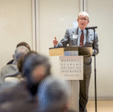From Transition to Transformation: Key Lessons from the Pandemic for Nonprofits
Key lessons from the pandemic that can help other nonprofit leaders proactively anticipate the next big jolt.

A return-to-normal mindset will not help nonprofits succeed post-pandemic.
In the past 2+ years, nonprofits have weathered the effects of the COVID-19 pandemic and its economic consequences on their organizations’ culture, operations, and funding.
Even as we return to some degree of in-person activities, a return-to-normal mindset is not the perspective that will enable nonprofits to succeed going forward.
The likelihood of another severe health and/or economic shock — whether from another pandemic, a climate disaster, a cyber-attack, or some other unfathomable catastrophe — cannot be minimized.
As CEO of the National Academy of Social Insurance for the past six years (and chair of its board of directors before that), I too have had to scramble during an ongoing global catastrophe.
And yet, I have learned several key lessons from the pandemic and its evolution into an endemic. It is my hope that these lessons will help other nonprofit leaders proactively anticipate the next big jolt.
Lesson One: Organization agility requires feedback loops.
As we are all aware, the pandemic necessitated swift pivoting, the most significant of which was the need to migrate quickly from in-person to virtual meetings and events via platforms like Zoom and Microsoft Teams. We also swiftly recognized the limitations of such platforms and had to compensate for them by using alternative (often old-fashioned) communication vehicles. Zoom fatigue was real.
One lasting effect is the recognition that, going forward, all Academy events will be hybrid, combining in-person participation with simultaneous virtual streaming. Ensuring that virtual participants obtain as much value as in-person participants will be an ongoing challenge. Systematic feedback loops will be essential.
For your organization, consider whether a suggestion box, either physical or more likely virtual, might be implemented in order to increase the agility of your organization. Encouraging both virtual and in-person participants to share feedback will help make sure that no one in your organization gets left behind or feels disengaged. This feedback might take the form of a survey, a bi-weekly email, or another form of check-in to see both what individuals think is working and what might yet be improved.
Lesson Two: Finding the right balance between in-person and virtual activities can free up budget for other areas that further your organization’s mission.
To recover from lost revenues due to the pandemic and its recession, we applied for federal financial assistance. However, resorting to more virtual activities also resulted in substantial cost savings as we had previously relied on in-person meetings and events that incurred costs for travel, lodging, meals, and facilities. The challenge going forward will be to strike the optimal balance between in-person and remote activities.
For your organization, consider what activities will work remotely. Even though all organizations are attempting to get back to normal (whatever that looks like), many people will still not be comfortable attending events in person, and, as you probably well know, remote activities are usually cheaper to put together. Consider whether your organization might be able to put the money originally used for some in-person events towards other activities that further your organization’s mission. While an in-person event that thanks donors might be fun, you must consider whether that money might be better dedicated towards other ventures.
Lesson Three: Being people oriented is crucial to building a culture of resilience.
Like many in the nonprofit world, our primary concern during the pandemic has been, and continues to be, the health and safety of the Academy’s small but enormously productive staff. These concerns were especially acute for staff with caregiving responsibilities. We have intentionally involved all staff in our planning for every aspect of our operations affected by the pandemic. Both physical and mental health needs are being addressed. As our staff recently joined a union, which our board supported, we have also utilized a new collective bargaining contract process to help formulate a re-entry plan.
Throughout the pandemic, members of the board also joined virtual staff meetings individually as demonstrations of their commitment to helping all of us get through this unimaginable crisis. Board-staff interaction, which is typically the exception rather than the rule when it comes to nonprofit governance, was an extraordinary response to extraordinary times. It has paid off greatly in terms of staff morale and better board understanding of the stress staff continue to work under.
However, we too were affected by the Great Resignation. As a result of the pandemic and their completely remote work, several employees found themselves questioning their previous work-life balance and seeking different careers that our organization is not equipped to offer. While clearly a disruptive development, we handled these transitions with dedication to the dignity of each individual and respect for their life-changing decisions.
For your organization, make sure that your people always come first. Involve your staff in operational planning, whether that manifests in roundtable meetings or brainstorming sessions. Encourage your board to get involved as well so that they can see the operational struggles your staff deals with on a day-to-day basis.
However, you also must understand that the pandemic has pulled the wool from many people’s eyes, so to speak. And so, if members of your staff decide that they must resign, do not take offense but rather support them in their transitions. Maintaining and nurturing staff is crucial to a nonprofit’s culture of resilience, and this includes making sure they are supported in their transitions from your organization.
Lesson Four: Reexamine your impact and inclusivity of diverse voices to make real and lasting change.
All nonprofit organizations are being challenged continuously to document the impact they have on their constituents and their causes. For the Academy, the urgency created by the pandemic caused us to focus less on inputs (e.g., policy conferences) or outputs (e.g., policy reports), and more on outcomes (e.g., actual changes in policies). Put more simply, we wanted tangible evidence that we were affecting real and lasting change.
In addition, the disparate effects of the pandemic and the recession on communities of color and other disadvantaged groups spurred the Academy to reinforce its commitment to racial justice in all our work.
The pandemic also caused us to broaden our scope of scholarship to include practitioners on the frontlines of service to and advocacy for the beneficiaries of social insurance programs. The diverse and vivid voices of these stakeholders are now incorporated into the entire range of our policy activities.
Lesson Five: Reevaluate your fundraising and don’t be afraid to be ambitious by taking a dramatically different approach from what you were doing before the pandemic.
All the lessons noted above have inspired significant changes in our approach to fundraising, which is how I now spend much of my time. As a result of these insights, the Academy has embarked on an ambitious multi-year growth strategy, called Pathways to Economic Security, which will serve as our primary policy and fundraising vehicle. If successful, this campaign should quadruple our revenues throughout the next four years.
This strategy represents a dramatic departure from how the Academy had previously approached fundraising, as it relies more on campaign core sponsorships and less on project-specific grants and contracts. Instead of applying for grants and contracts, the Academy will now work with sponsors. It is our hope that this change allows us to focus more on the Academy’s mission and less on chasing individual grants and funding.
We also hired a fundraising consulting firm to help us take a fresh look at all development activities including how we translate our policy work into more understandable deliverables, how we track our impact, and how we communicate with current and potential funders. We plan to measure the return on this investment by specific increases in Academy revenues, as well as a more diversified portfolio of types of funders.
From Transition to Transformation
In short, the overall experience of the pandemic is causing a truly transformative change in our more than 35-year-old organization. While some nonprofits have described the consequences of the pandemic as a transition, we have decided to take the bolder view of transformation. However, this exciting experience is not feasible without leadership—including our board—willing to learn from these distressing times and taking calculated risks based on the five lessons.
Successful nonprofits and their leadership can emerge from the pandemic even stronger and more dedicated to their missions. By doing so, they will not merely survive, but thrive.
You might also like:
- When the Board Becomes the Problem: Reclaiming Power in Nonprofit Leadership
- Why Human-Centered AI Adoption Matters for Nonprofits
- The New Sheriff in Town: Tips for Successfully Leading a Nonprofit Team (that Someone Else Built)
- When the System Fails Quietly: What I’ve Learned from Sitting Between the Frontline and the Data
- A Board Member “Contract”
You made it to the end! Please share this article!
Let’s help other nonprofit leaders succeed! Consider sharing this article with your friends and colleagues via email or social media.
About the Author
Articles on Blue Avocado do not provide legal representation or legal advice and should not be used as a substitute for advice or legal counsel. Blue Avocado provides space for the nonprofit sector to express new ideas. The opinions and views expressed in this article are solely those of the authors. They do not purport to reflect or imply the opinions or views of Blue Avocado, its publisher, or affiliated organizations. Blue Avocado, its publisher, and affiliated organizations are not liable for website visitors’ use of the content on Blue Avocado nor for visitors’ decisions about using the Blue Avocado website.







